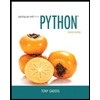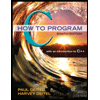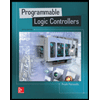
Database System Concepts
7th Edition
ISBN: 9780078022159
Author: Abraham Silberschatz Professor, Henry F. Korth, S. Sudarshan
Publisher: McGraw-Hill Education
expand_more
expand_more
format_list_bulleted
Question

Transcribed Image Text:2. Create a java class as the next diagram and make some objects and print outputs. Note:
setRadius, setColor, setRadiusColor both are mutators. The default constructor will initliaize
radius to 1, and color to "red". The other constructor will call setRadiusColor method.
Circle
+ radius: double
- color: String
+Circle()
+Circle(color:String, radius:double)
+ getRadius(): double
+ setRadius (radius: double): void
+setColor(color:String):void
+getColor():String
+setRadiusColor(color:String,
radius:double):void
+equals(c:Circle) : Boolean
Expert Solution
This question has been solved!
Explore an expertly crafted, step-by-step solution for a thorough understanding of key concepts.
This is a popular solution
Trending nowThis is a popular solution!
Step by stepSolved in 3 steps with 4 images

Knowledge Booster
Similar questions
- Java Instance data:Variable mpg for fuel efficiency (miles per gallon = mpg)Variable gas to save how many gallons of gas left in the tank Constructors:Default constructor with no parameter. Use 0 as initial values.Overloaded constructor with two parameters Methods:getMPG() & setMPG()(getGas() & setGas()toString() methoddrive() to simulate that the car is driven for certain miles. For example, v1.drive(100) means vehicle v1 is driven 100 miles. You need to calculate the gas cost and update the gas tank: gas = gas - miles/mpg. You also need to check if there is enough gas left since gas should not be negative. You need to figure out the formal parameters for the above methods. In the testing class, prompt the user for information to create two objects of the Vehicle class. Let each vehicle drive 200 miles. Print out the left gas for each vehicle. Ex: Vehicle 1 Enter the mpg: 40 Enter the gas left: 10.5 Vehicle 2 Enter the mpg: 35 Enter the gas left: 2.1 Vehicle 1…arrow_forwardThe Factory method design pattern is useful since it can be used to create new objects of a particular type dynamically. True Falsearrow_forwardWrite a Rectangle class. Its constructor should accept length and width as a parameter. It should have methods that return its length, width, perimeter, and area. (Use Java) Show a demonstration where you create two separate rectangles.arrow_forward
- The goal of this coding exercise is to create two classes BookstoreBook and LibraryBook. Both classes have these attributes: author: Stringtiltle: Stringisbn : String- The BookstoreBook has an additional data member to store the price of the book, and whether the book is on sale or not. If a bookstore book is on sale, we need to add the reduction percentage (like 20% off...etc). For a LibraryBook, we add the call number (that tells you where the book is in the library) as a string. The call number is automatically generated by the following procedure:The call number is a string with the format xx.yyy.c, where xx is the floor number that is randomly assigned (our library has 99 floors), yyy are the first three letters of the author’s name (we assume that all names are at least three letters long), and c is the last character of the isbn.- In each of the classes, add the setters, the getters, at least three constructors (of your choosing) and override the toString method (see samplerun…arrow_forwardFor this assignment, create a child class of car that creates a car of a randomly generated color. Using the existing car classes, add code to add 20 colored cars to the existing pane in 20 visible, random locations. You will end up with 4 classes: CarViewer.java CarComponent.java Car.java (unchanged from Chapter 3) ColorCar.java (extends Car)arrow_forwardCreate a Class Student in which we have three instance variables emp_name, emp_id, and Salary. Write getter and setters for each instance variable. Write another Display method that displays the record of Employee. In Main create five Employee’s Objects. Set their values as required and display as well. In the end Display top three employees with respect to Salary (Display those who have more Salary among all).arrow_forward
- Create a UML diagram to document the Cuboid class. You can model this class after the Rectangle class we covered in this chapter. It should have 3 data fields: width, length, height. It should have 3 accessors and 3 mutators. It should have a method that calculates the volume of the cuboid. Save your file in MS Word or PDF format. Hint: In MS Word, you can create a table of 1 column and 3 rows. What is a cuboid? You can consider a cuboid as a cube whose length, width, and height may not be equal to each other.arrow_forwardComplete the Car class by creating an attribute purchase_price (type int) and the method print_info() that outputs the car's information. Ex: If the input is: 2011 18000 2018 where 2011 is the car's model year, 18000 is the purchase price, and 2018 is the current year, then print_info() outputs: Car's information: Model year: 2011 Purchase price: $18000 Current value: $5770 Note: print_info() should use two spaces for indentation.arrow_forwardPlease help me with my assignment for computer science as I had all the dialog box pop up for me except for "Whew" what am I doing wrong? I am including with this message the coding block for the assignment. import java.awt.event.*;import javax.swing.*;public class MouseWhisperer extends JFrame implements MouseListener {MouseWhisperer() {super("COME CLOSER");setSize(300,100);setDefaultCloseOperation(JFrame.EXIT_ON_CLOSE);addMouseListener(this);setVisible(true);}public void mouseClicked(MouseEvent e) { setTitle("OUCH"); }public void mousePressed(MouseEvent e) { setTitle("LET GO"); }public void mouseReleased(MouseEvent e) { setTitle("WHEW"); }public void mouseEntered(MouseEvent e) { setTitle("I SEE YOU"); }public void mouseExited(MouseEvent e) { setTitle("COME CLOSER"); }public static void main(String[] args) { new MouseWhisperer(); }} Please advice.arrow_forward
- a constructor that takes in an int, a string, and a double, constructor will assign them to the ID, name, and Averageinstance variables, then a no-argument (zero-parameter) constructor that will set the ID to the name to “No name assigned” and the Average to –1.0. With an accessor method for the name variable and a mutator method for the average variable. a toString() method that will display all three instance variables on a single line, with a " | " between each one. and then an equals() method that returns true only if all three instance variables are equalarrow_forwardplease write code in java Create a right triangle class with instance variables(double) for sideA, sideB and the hypo. write three constructors -the 2-param version assigns to sides A and B respectively. the 1-param version assigns the same value to both sides. the 0-param version assigns 10.0 to each side. the constructor also computes the hypotenuse based on the other two sides and saves that in the hypotenuse variable. Create accessors for all three variables. Write a toString() that will print/label the three sides. write some main code to create three instances of your class, one to test each of your constructors. you can input values or use fixed values. Display each instance using an implicit toString() call.arrow_forwardFor this lab task, you will work with classes and objects. Create a class named text that works similar to the built-in string class. You will need to define a constructor that can be used to initialize objects of this new class with some literal text. Next, define three methods: to_upper() that will convert all characters to uppercase, reverse() that will reverse the text and length() that will return the length of the text. After you have completed this part, copy the following mainfunction to your code and check if the implementation is correct. int main() { text sample = "This is a sample text"; cout << sample.to_upper(); // This should display "THIS IS A SAMPLE TEXT" cout << endl;cout << sample.reverse(); // This should display "txet elpmas a si sihT"cout << endl; cout << sample.length(); // This should display 21 }arrow_forward
arrow_back_ios
SEE MORE QUESTIONS
arrow_forward_ios
Recommended textbooks for you
 Database System ConceptsComputer ScienceISBN:9780078022159Author:Abraham Silberschatz Professor, Henry F. Korth, S. SudarshanPublisher:McGraw-Hill Education
Database System ConceptsComputer ScienceISBN:9780078022159Author:Abraham Silberschatz Professor, Henry F. Korth, S. SudarshanPublisher:McGraw-Hill Education Starting Out with Python (4th Edition)Computer ScienceISBN:9780134444321Author:Tony GaddisPublisher:PEARSON
Starting Out with Python (4th Edition)Computer ScienceISBN:9780134444321Author:Tony GaddisPublisher:PEARSON Digital Fundamentals (11th Edition)Computer ScienceISBN:9780132737968Author:Thomas L. FloydPublisher:PEARSON
Digital Fundamentals (11th Edition)Computer ScienceISBN:9780132737968Author:Thomas L. FloydPublisher:PEARSON C How to Program (8th Edition)Computer ScienceISBN:9780133976892Author:Paul J. Deitel, Harvey DeitelPublisher:PEARSON
C How to Program (8th Edition)Computer ScienceISBN:9780133976892Author:Paul J. Deitel, Harvey DeitelPublisher:PEARSON Database Systems: Design, Implementation, & Manag...Computer ScienceISBN:9781337627900Author:Carlos Coronel, Steven MorrisPublisher:Cengage Learning
Database Systems: Design, Implementation, & Manag...Computer ScienceISBN:9781337627900Author:Carlos Coronel, Steven MorrisPublisher:Cengage Learning Programmable Logic ControllersComputer ScienceISBN:9780073373843Author:Frank D. PetruzellaPublisher:McGraw-Hill Education
Programmable Logic ControllersComputer ScienceISBN:9780073373843Author:Frank D. PetruzellaPublisher:McGraw-Hill Education

Database System Concepts
Computer Science
ISBN:9780078022159
Author:Abraham Silberschatz Professor, Henry F. Korth, S. Sudarshan
Publisher:McGraw-Hill Education

Starting Out with Python (4th Edition)
Computer Science
ISBN:9780134444321
Author:Tony Gaddis
Publisher:PEARSON

Digital Fundamentals (11th Edition)
Computer Science
ISBN:9780132737968
Author:Thomas L. Floyd
Publisher:PEARSON

C How to Program (8th Edition)
Computer Science
ISBN:9780133976892
Author:Paul J. Deitel, Harvey Deitel
Publisher:PEARSON

Database Systems: Design, Implementation, & Manag...
Computer Science
ISBN:9781337627900
Author:Carlos Coronel, Steven Morris
Publisher:Cengage Learning

Programmable Logic Controllers
Computer Science
ISBN:9780073373843
Author:Frank D. Petruzella
Publisher:McGraw-Hill Education